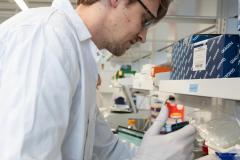The human body contains an extraordinary variety of cells from neurons to heart muscles to skin cells. While these cells play a wide-range of roles, they share the same need for nutrients, known as metabolites. Disruptions in the way metabolites are used and transported around the body underlie many childhood diseases and could be key to identifying new, life-changing treatments.
That’s what drives Dr. Seth Parker, one of BC Children’s Hospital's newest investigators and an expert in the proteins responsible for transporting metabolites into and out of a cell.

He joins BC Children’s as an investigator and the University of British Columbia Faculty of Medicine as an Assistant Professor in the department of Biochemistry and Molecular Biology. Previously, Dr. Parker was a postdoctoral fellow at New York University School of Medicine under Dr. Alec Kimmelman where he studied how the transport of specific metabolites are altered in pancreatic cancer. He completed his Ph.D. in Bioengineering at the University of California, San Diego where he engineered new methods to study cancer metabolism under Dr. Christian Metallo.
We talked to Dr. Parker about his research into metabolite transport and how it could help kids with cancer and other diseases.
What are metabolite transporters?
Metabolite transporters are proteins that sit within cell surfaces and carry nutrients or other molecules in and out of cells or compartments within cells.
We know there are at least 450 different transporter proteins that exist in humans, but we still don’t know what almost a third of them do.
Part of the reason for this is that many different transporters can ferry the same molecules, making it difficult to tease out the specific role of each transporter. Since these proteins are embedded in the cell surface, as opposed to floating around inside the cell, it can be difficult to isolate them for study.
Throughout my research I’ve used my background in bioengineering to develop better tools for studying these fascinating molecules and trace the flow of metabolites in a cell.
Why is it so important to understand where nutrients are going?
Metabolites like sugar and amino acids (the building blocks of proteins) are the fuel cells use to get different jobs done. Cells need to transport these metabolites to where they are needed to thrive.
For example, cancer cells grow and divide far more rapidly than a normal healthy cell and therefore have a much greater demand for energy and metabolites. In my previous work in pancreatic cancer, I focused on a specific amino acid called alanine. Normal, healthy cells can make alanine from sugar molecules instead of consuming them for energy. However, cancer cells have a voracious appetite for both amino acids and energy, so they must import alanine to meet their needs. Using my expertise in tracking metabolites and identifying proteins, our research team found the specific transporters pancreatic cancer cells use to ferry alanine in from outside the cell. Importantly, healthy cells have very little need for these transporters since they should be able to make their own alanine. Disrupting these specific transport proteins slowed tumour growth, suggesting that this could be used as a potential new therapy.
Studying childhood diseases from the perspective of metabolite transport is an entirely different approach that can give new insights. I am delighted to bring my knowledge and expertise to BC Children’s to help uncover potential new treatments.
What do you hope to do at BC Children’s?
I would like to take the knowledge, training and tools I have developed to help understand and treat diseases such as childhood cancer.
For example, I hope to apply the approaches from my work showing the importance of metabolite transport in pancreatic cancer to childhood leukemia.
For decades, one of the treatments used for leukemia has been to starve the body of asparagine a similar metabolite to alanine that is also needed more aggressively by cancer cells than healthy cells. However, this therapy also takes away asparagine from healthy cells which can lead to damaging side effects.
If we could target the specific transporters that leukemia cells use to acquire asparagine — since these cancer cells usually silence their own ability to make it — we could potentially reduce the side effects of this treatment by starving the cancer cells and sparing the healthy ones.
BC Children’s is already a leader in research that tracks what proteins are being produced by a cell. This gives researchers a key insight into what molecules and proteins a cell is making, but it doesn’t necessarily account for where those proteins and molecules are headed once they are produced, or how they are being used.
By applying the tools I have developed to help track metabolites with BC Children’s well established research expertise, we could gain a clearer picture of how cells control the flow of metabolites, how this is disrupted in disease and where we can manipulate this as a treatment.
What brought you to BC Children’s?
I love how collaborative research is at BC Children’s and am excited to be a part of the community here. It’s a big draw for me that BC Children’s has scientists and clinicians working together on many different areas of childhood disease.
Although my research to date has focused on cancer — tracking metabolites and identifying transporter proteins could also lead to new treatments for other childhood diseases, such as diabetes or rare genetic disorders. There are lots of opportunities to contribute and collaborate with different research teams. I also love the outdoors, and in particular rock climbing, so it’s fantastic to be able to live out here in B.C.




